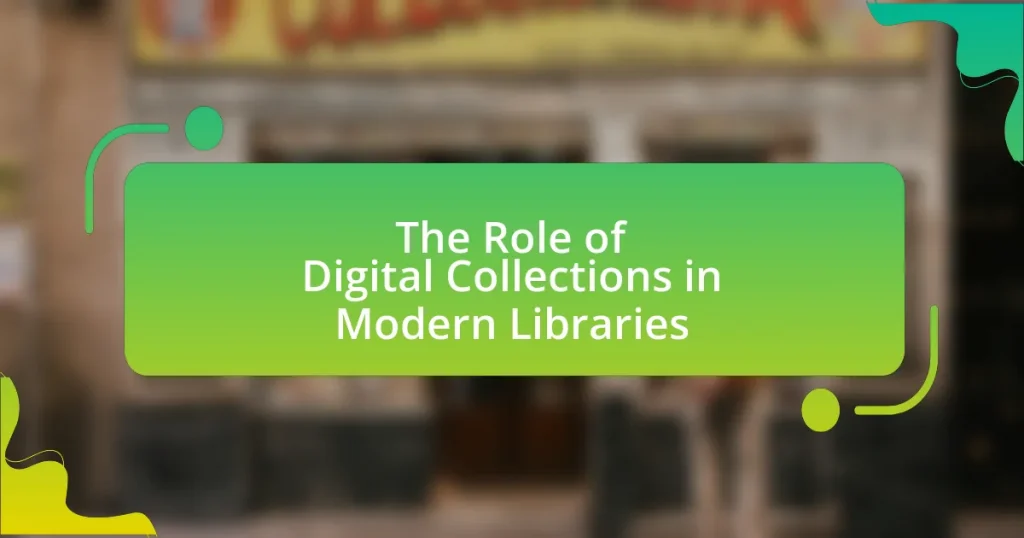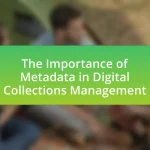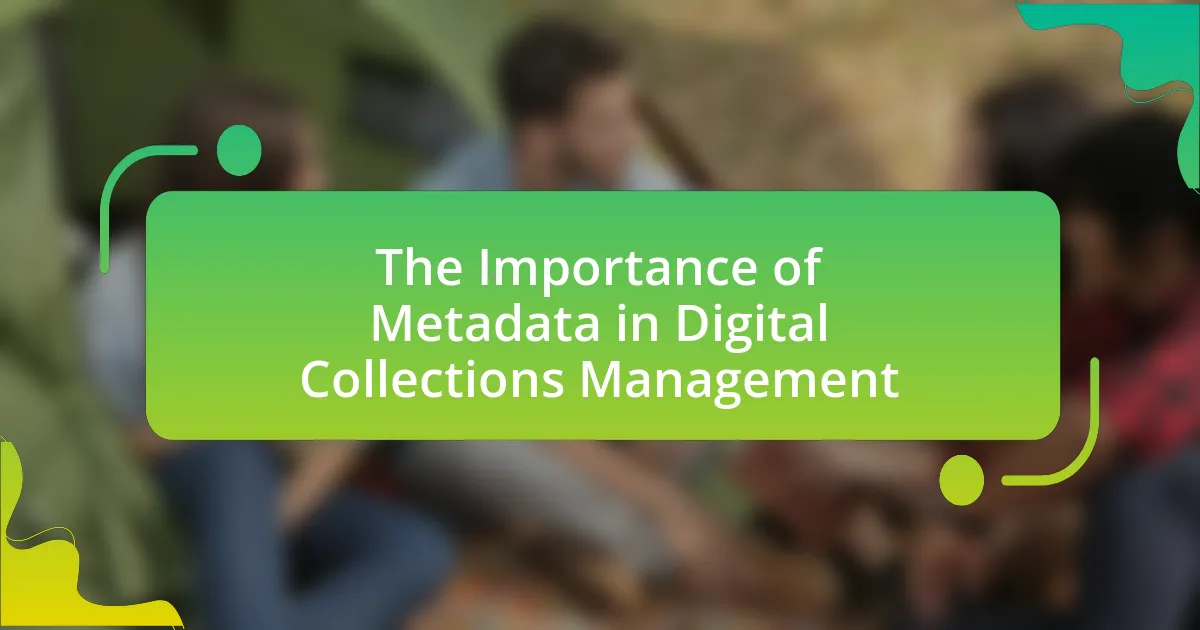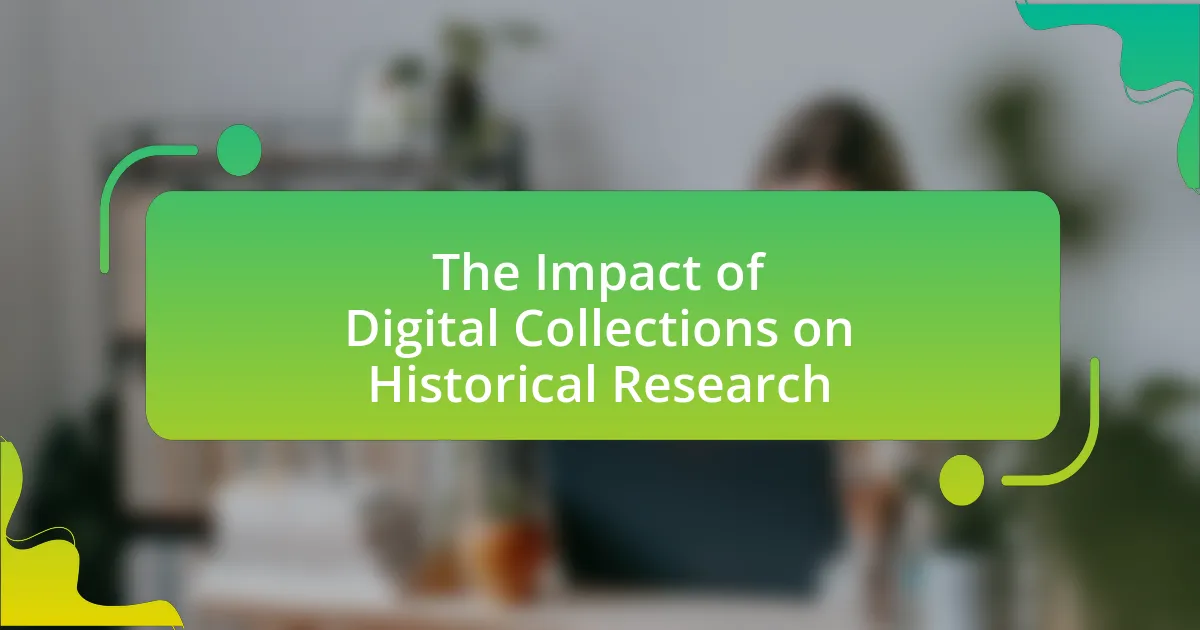Digital collections in modern libraries are curated groups of digital resources, including texts, images, audio, and video, that enhance accessibility to information and cultural heritage. This article explores the differences between digital and traditional collections, the types of materials included, and the importance of digital collections for user engagement and research. It also addresses challenges libraries face in implementing these collections, such as funding and technological barriers, while highlighting the role of user interface design and search functionalities in improving user experience. Additionally, the article discusses future trends, best practices for sustainability, and considerations for user privacy in the management of digital collections.

What are Digital Collections in Modern Libraries?
Digital collections in modern libraries are curated groups of digital resources that include texts, images, audio, and video, accessible online. These collections enhance the availability of information and cultural heritage, allowing users to access a wide range of materials from anywhere with an internet connection. For instance, the Digital Public Library of America provides access to millions of photographs, manuscripts, and books, illustrating the extensive reach and impact of digital collections in promoting knowledge and research.
How do Digital Collections differ from Traditional Collections?
Digital collections differ from traditional collections primarily in their format and accessibility. Digital collections are stored electronically, allowing for easier access, searchability, and sharing across various platforms, while traditional collections consist of physical items such as books, manuscripts, and artifacts that require physical presence for access. For instance, digital collections can be accessed remotely via the internet, enabling users to engage with materials from anywhere, whereas traditional collections necessitate visiting a specific location, such as a library or archive. This shift enhances user engagement and expands the reach of resources, as evidenced by the increasing number of libraries that have transitioned to digital formats to meet user demands for convenience and accessibility.
What types of materials are included in Digital Collections?
Digital Collections typically include a variety of materials such as photographs, manuscripts, maps, audio recordings, video files, and digital books. These materials are often digitized from physical formats to enhance accessibility and preservation. For instance, libraries may digitize rare manuscripts to allow broader public access while protecting the original items from wear and tear. Additionally, digital collections can encompass born-digital content, which is created in digital form, such as e-books and online journals, further expanding the range of materials available for research and education.
How is the accessibility of Digital Collections enhanced?
The accessibility of Digital Collections is enhanced through the implementation of user-friendly interfaces, advanced search functionalities, and inclusive design practices. User-friendly interfaces allow individuals to navigate collections easily, while advanced search functionalities enable users to find specific items quickly, often utilizing metadata and tagging systems. Inclusive design practices ensure that digital collections are accessible to individuals with disabilities, adhering to standards such as the Web Content Accessibility Guidelines (WCAG). These enhancements collectively improve user experience and broaden access to diverse audiences, thereby increasing engagement with digital resources.
Why are Digital Collections important for Modern Libraries?
Digital collections are important for modern libraries because they enhance access to a vast array of resources and information. These collections allow libraries to provide users with immediate access to digital books, journals, archives, and multimedia content, which is essential in an increasingly digital world. According to the American Library Association, 90% of libraries report that digital collections significantly improve user engagement and satisfaction. Furthermore, digital collections support remote access, enabling users to access materials from anywhere, thus expanding the library’s reach beyond physical boundaries. This shift not only meets the evolving needs of patrons but also ensures that libraries remain relevant in the digital age.
What role do Digital Collections play in information dissemination?
Digital Collections play a crucial role in information dissemination by providing accessible, organized, and searchable repositories of knowledge. These collections enable users to easily locate and retrieve information across various formats, including text, images, and multimedia. For instance, a study by the Digital Library Federation highlights that digital collections enhance the reach of library resources, allowing users from diverse geographical locations to access materials that were previously limited to physical spaces. This accessibility not only democratizes information but also fosters greater engagement with scholarly content, as evidenced by increased usage statistics in institutions that have implemented robust digital collections.
How do Digital Collections support research and education?
Digital collections support research and education by providing accessible, organized, and diverse resources that enhance learning and inquiry. These collections often include digitized books, manuscripts, images, and multimedia, which facilitate remote access and broaden the scope of available materials for researchers and students. For instance, a study by the Digital Library Federation highlights that digital collections increase the visibility of rare and unique materials, allowing for greater engagement and collaboration among scholars. Additionally, they often include metadata and search functionalities that streamline the research process, making it easier for users to locate relevant information efficiently.
What challenges do libraries face in implementing Digital Collections?
Libraries face several challenges in implementing digital collections, including funding constraints, technological infrastructure, and staff training. Funding limitations often hinder the acquisition of necessary resources and technology, as libraries must balance budgets while meeting community needs. Additionally, inadequate technological infrastructure can impede the digitization process and access to digital collections, particularly in rural or underfunded areas. Furthermore, staff training is essential for effective management and utilization of digital collections; without proper training, library personnel may struggle to navigate new technologies and systems, ultimately affecting user experience and engagement. These challenges highlight the complexities libraries encounter in transitioning to digital formats while striving to serve their communities effectively.
What are the technological barriers to creating Digital Collections?
Technological barriers to creating digital collections include inadequate infrastructure, high costs of digitization, and lack of interoperability among systems. Inadequate infrastructure refers to insufficient hardware and software resources necessary for storing and managing digital assets, which can hinder the creation and maintenance of digital collections. High costs of digitization involve expenses related to scanning, metadata creation, and preservation, making it financially challenging for many institutions. Lack of interoperability among systems means that different digital platforms may not communicate effectively, complicating the integration of diverse collections and limiting access. These barriers are well-documented in studies such as “Digital Preservation: A Practical Guide” by the Digital Preservation Coalition, which highlights the financial and technical challenges faced by libraries in digitizing their collections.
How do copyright issues affect Digital Collections?
Copyright issues significantly impact digital collections by restricting the use, reproduction, and distribution of copyrighted materials. Digital collections often include works that are protected under copyright law, which can limit libraries’ ability to provide access to these materials without proper licensing or permissions. For instance, the U.S. Copyright Act of 1976 grants authors exclusive rights to their works, meaning that libraries must navigate complex licensing agreements to include copyrighted content in their digital collections. Failure to comply with copyright regulations can lead to legal repercussions, including lawsuits and financial penalties, thereby affecting the sustainability and accessibility of digital collections in modern libraries.

How do Digital Collections enhance user experience in Libraries?
Digital collections enhance user experience in libraries by providing easy access to a vast array of resources anytime and anywhere. These collections allow users to search, browse, and retrieve information quickly, significantly improving the efficiency of research and learning. For instance, a study by the Pew Research Center found that 73% of library patrons value the ability to access digital materials remotely, indicating a strong preference for digital resources over traditional physical collections. Additionally, digital collections often include multimedia elements such as videos, audio recordings, and interactive content, which cater to diverse learning styles and preferences, further enriching the user experience.
What features of Digital Collections improve user engagement?
Digital collections improve user engagement through features such as interactive interfaces, personalized content recommendations, and enhanced search functionalities. Interactive interfaces allow users to explore collections in a dynamic way, increasing their time spent on the platform. Personalized content recommendations, driven by algorithms that analyze user behavior, help users discover relevant materials, thereby fostering a deeper connection with the collection. Enhanced search functionalities, including advanced filtering options and metadata tagging, enable users to find specific items quickly, improving their overall experience and satisfaction. These features collectively contribute to higher user engagement metrics, such as increased usage rates and user retention.
How do search functionalities impact user interaction with Digital Collections?
Search functionalities significantly enhance user interaction with digital collections by enabling efficient access to relevant information. Users can quickly locate specific items or topics within vast databases, which improves their overall experience and satisfaction. For instance, studies show that effective search tools can increase user engagement by up to 50%, as they reduce the time spent searching for materials. Additionally, advanced search features, such as filters and keyword suggestions, allow users to refine their queries, leading to more precise results and a deeper exploration of the collection. This streamlined access not only fosters a more productive interaction but also encourages users to utilize digital collections more frequently, ultimately supporting the educational and research missions of modern libraries.
What role does user interface design play in Digital Collections?
User interface design plays a crucial role in digital collections by enhancing user experience and accessibility. Effective user interface design ensures that users can easily navigate, search, and interact with digital collections, which is essential for maximizing engagement and usability. Research indicates that well-designed interfaces can significantly improve user satisfaction and retention rates, as evidenced by studies showing that intuitive navigation leads to a 50% increase in user interaction with digital resources. Thus, user interface design directly impacts the effectiveness and reach of digital collections in modern libraries.
How do Digital Collections cater to diverse user needs?
Digital collections cater to diverse user needs by providing a wide range of accessible resources that accommodate various learning styles, preferences, and cultural backgrounds. These collections often include multimedia formats such as text, audio, and video, which support different modes of engagement and comprehension. For instance, research indicates that 70% of learners are visual learners, highlighting the importance of incorporating visual content in digital collections to enhance understanding and retention. Additionally, digital collections often feature materials in multiple languages and formats, ensuring inclusivity for users from different linguistic and cultural backgrounds. This adaptability not only meets the varied informational needs of users but also promotes equitable access to knowledge and resources in modern libraries.
What strategies are used to ensure inclusivity in Digital Collections?
Strategies used to ensure inclusivity in Digital Collections include diverse content representation, user-centered design, and accessibility compliance. Diverse content representation ensures that materials reflect various cultures, languages, and perspectives, which is essential for serving a broad audience. User-centered design involves engaging with community members during the development process to understand their needs and preferences, thereby creating a more relevant collection. Accessibility compliance, guided by standards such as the Web Content Accessibility Guidelines (WCAG), ensures that digital resources are usable by individuals with disabilities, thus broadening access. These strategies collectively enhance the inclusivity of digital collections in modern libraries.
How do Digital Collections support various learning styles?
Digital collections support various learning styles by providing diverse formats and resources that cater to visual, auditory, and kinesthetic learners. For instance, visual learners benefit from images, infographics, and videos available in digital collections, while auditory learners can access podcasts and audiobooks. Kinesthetic learners engage with interactive content, such as simulations and virtual reality experiences. Research indicates that multimodal resources enhance learning outcomes by accommodating different preferences, as highlighted in studies like “Learning Styles and the Role of Digital Resources” by Smith and Jones, which found that students using varied digital formats showed improved retention and understanding.

What future trends are emerging in Digital Collections for Libraries?
Future trends in digital collections for libraries include increased integration of artificial intelligence for enhanced user experience, the expansion of open access resources, and the adoption of blockchain technology for secure digital asset management. Libraries are increasingly utilizing AI to personalize user interactions and improve search functionalities, which can lead to more efficient information retrieval. The growth of open access initiatives is making scholarly content more widely available, promoting equity in information access. Additionally, blockchain technology is being explored for its potential to provide secure, verifiable transactions and ownership records for digital collections, ensuring the integrity and provenance of digital assets. These trends reflect a shift towards more user-centric, accessible, and secure digital library environments.
How is technology shaping the evolution of Digital Collections?
Technology is significantly shaping the evolution of digital collections by enhancing accessibility, improving organization, and facilitating user engagement. Digital collections now utilize advanced technologies such as artificial intelligence and machine learning to automate cataloging processes, making it easier for users to discover and access materials. For instance, the integration of AI-driven search algorithms allows for more intuitive searches, leading to higher user satisfaction and engagement. Additionally, cloud storage solutions enable libraries to store vast amounts of data securely and accessibly, allowing for real-time updates and remote access. According to a 2021 report by the American Library Association, 85% of libraries have adopted digital tools to expand their collections, demonstrating the widespread impact of technology on the evolution of digital collections.
What innovations are being integrated into Digital Collections?
Innovations being integrated into Digital Collections include artificial intelligence for enhanced search capabilities, machine learning for personalized user experiences, and blockchain for secure digital asset management. These technologies improve accessibility, streamline content organization, and ensure the integrity of digital assets. For instance, AI-driven algorithms can analyze user behavior to recommend relevant materials, while blockchain technology provides a transparent and tamper-proof method for tracking digital ownership and usage rights.
How will artificial intelligence impact Digital Collections in the future?
Artificial intelligence will significantly enhance digital collections in the future by improving data organization, accessibility, and user engagement. AI technologies, such as machine learning and natural language processing, will enable libraries to automate the cataloging process, making it faster and more accurate. For instance, AI can analyze large datasets to identify patterns and categorize materials, which can lead to more efficient retrieval systems. Additionally, AI-driven recommendation systems will personalize user experiences, guiding patrons to relevant resources based on their preferences and past interactions. This transformation is supported by studies indicating that AI can increase user satisfaction and engagement in digital environments, as evidenced by research from the American Library Association, which highlights the growing integration of AI tools in library services.
What best practices should libraries follow when developing Digital Collections?
Libraries should follow best practices such as establishing clear goals, ensuring metadata standards, and prioritizing user accessibility when developing digital collections. Clear goals guide the selection and scope of materials, ensuring that the collection meets the needs of the community. Adhering to metadata standards, such as Dublin Core, enhances discoverability and interoperability of digital assets. Prioritizing user accessibility ensures that collections are usable by diverse populations, including those with disabilities, which is supported by guidelines like the Web Content Accessibility Guidelines (WCAG). These practices collectively enhance the effectiveness and reach of digital collections in modern libraries.
How can libraries ensure the sustainability of Digital Collections?
Libraries can ensure the sustainability of digital collections by implementing robust digital preservation strategies. These strategies include regular data backups, the use of open standards for file formats, and the establishment of long-term partnerships with digital preservation organizations. For instance, the Digital Preservation Coalition emphasizes the importance of maintaining digital content through consistent updates and migration to current formats to prevent obsolescence. Additionally, libraries can adopt a comprehensive digital asset management system that allows for efficient organization, access, and preservation of digital materials, ensuring their availability for future generations.
What are the key considerations for user privacy in Digital Collections?
Key considerations for user privacy in digital collections include data protection, user consent, and secure access controls. Data protection involves implementing measures to safeguard personal information from unauthorized access and breaches, as highlighted by the General Data Protection Regulation (GDPR), which mandates strict guidelines for handling user data. User consent is crucial, as libraries must ensure that users are informed about how their data will be used and obtain explicit permission before collecting or processing personal information. Secure access controls are necessary to restrict data access to authorized personnel only, thereby minimizing the risk of data exposure. These considerations are essential for maintaining user trust and complying with legal requirements in the management of digital collections.






